Fitness routines have changed a lot in recent years. Home-based exercise is now a top choice for millions. It’s great if you’re busy or like privacy. You can turn your living room into a gym without fancy gear.
Bodyweight moves like squats, planks, and bridges are perfect. They help build strength, boost endurance, and manage weight well.
One big plus is how easy it scales. Beginners can start with simple versions, and advanced folks can make it harder. Studies show these workouts improve your heart health and muscle tone over time.
And you’ll save money on gym memberships. Plus, you won’t have to commute.
Platforms like Daily Burn offer lots of structured programs. They have thousands of videos ready for you. You can fit in a workout anytime, whether it’s 15 minutes or an hour.
No need to rush or wait for equipment. Just press play and start moving.
Key Takeaways
- Bodyweight exercises require no equipment and suit all fitness levels.
- Home routines save time and money compared to traditional gyms.
- Scalable workouts grow with your progress, keeping challenges fresh.
- Flexible scheduling lets you exercise anytime, without restrictions.
- Online platforms provide endless variety to prevent boredom.
Cost-Effective Fitness Solutions
Why spend hundreds on gym fees when you can get similar results at home for less? Home workouts save money and help you stay healthy. Here are three ways to save without losing quality.
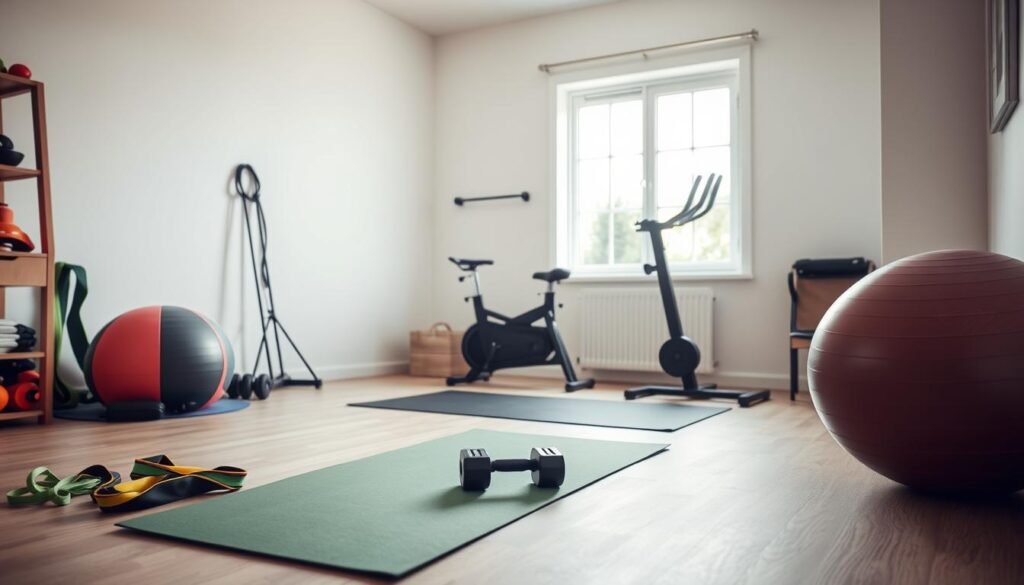
Save on Gym Memberships
Gym memberships in the U.S. cost about $58/month, or $700 a year. Add in costs for fuel, parking, and smoothies, and expenses add up quickly. Switching to home workouts cuts these costs right away. For example, a $25 resistance band can replace gym fees for months and offers many strength training options.
Invest in Home Equipment
Begin with basics like yoga mats and dumbbells, then add more as you go. Many everyday items can also be used for workouts:
- Use chairs for tricep dips or elevated push-ups
- Fill water bottles as makeshift weights
- Fold towels for yoga blocks
This method keeps costs low and lets you create your own setup.
Utilize Free Online Resources
Platforms like Nike Training Club and FitnessBlender offer thousands of free workouts. YouTube channels like Yoga With Adriene or Blogilates have sessions for all levels. As one fitness influencer says:
“Your living room can become a studio—no subscription required.”
By using affordable gear and online guides, you can enjoy the home workout advantages of saving money and flexibility. Every dollar saved means more money for you, helping you focus on your fitness journey.
Flexibility and Convenience
Home fitness breaks down barriers, letting you fit workouts into your life. This makes exercise flexible, perfect for busy people. It’s great for parents, remote workers, and anyone looking for time-efficient fitness strategies.
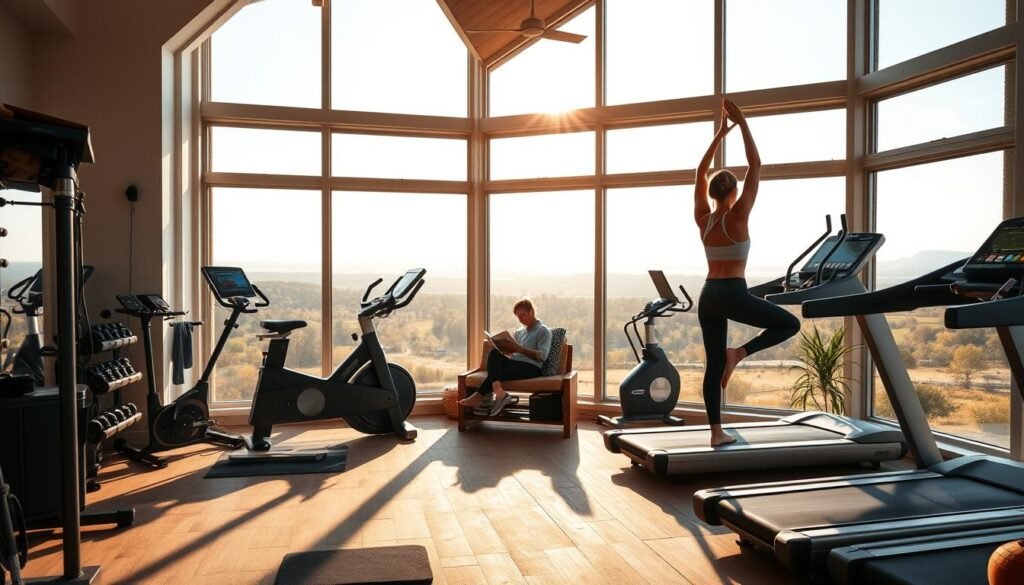
Tailor Your Workout Schedule
Your living room is always ready for a workout. Do yoga at dawn or HIIT during lunch. Home workouts fit your life, not the other way around.
- Shift work schedules
- Childcare responsibilities
- Last-minute plan changes
Work out whenever you’re most awake. Moonlit Pilates for night owls, weights at dawn for early risers. This schedule autonomy keeps you consistent, even when life gets busy.
Create a Personalized Space
Turn any spot into your fitness haven. A corner with bands and a mat beats a messy basement treadmill. Here’s how to optimize your space:
- Use vertical storage for equipment
- Position mirrors to check form
- Add motivational decor like progress charts
A well-organized space makes starting exercise easier. It saves time and boosts motivation.
Avoid Commute Time
Save 3-5 hours a week by avoiding gym trips. Use this time for:
- Streaming your favorite show while cycling
- Preparing healthy meals after working out
- Changing into workout clothes without delay
One study shows 68% of home exercisers stick with it longer. This is because they save time. Listen to podcasts or make calls while doing squats or planks. Multitasking helps your fitness routine.
Improved Consistency
Building workout consistency at home is easier than you think. It’s the secret sauce for unlocking the health benefits of at-home exercise. When your gym is just steps away, sticking to a plan becomes second nature. Let’s explore how small changes can create lasting habits.
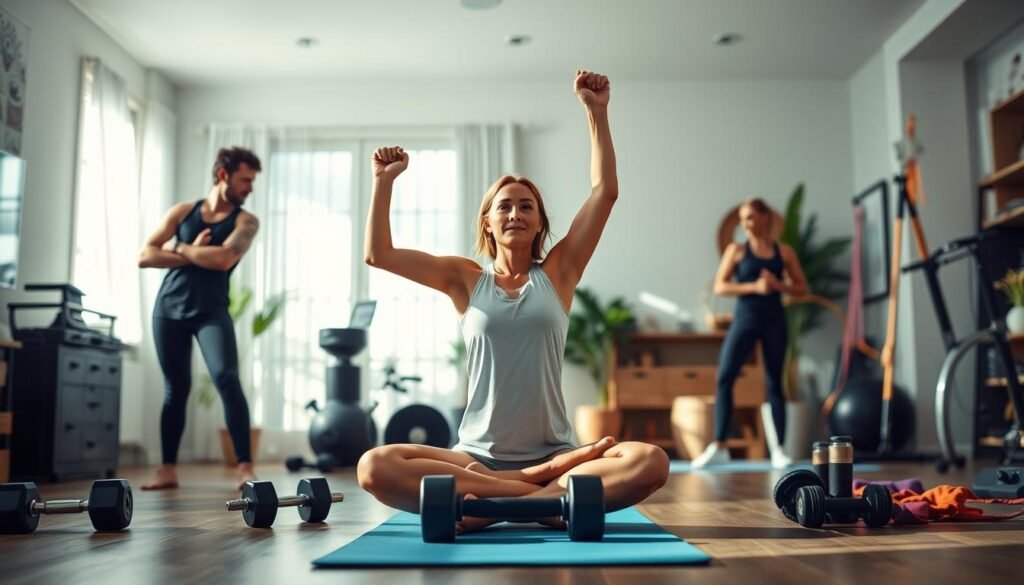
Establish a Routine
Start by anchoring workouts to existing daily habits. For example, pair a 15-minute morning stretch with your coffee ritual. Studies show that consistent timing increases adherence by 34% compared to irregular schedules. Try this simple framework:
- Choose a fixed time slot (even 10 minutes counts)
- Set visual reminders on your phone or calendar
- Track streaks using a habit-tracking app
Shorter Workouts Encourage Regularity
Source 1’s 15–20 minute beginner circuits prove that brief sessions work better for long-term success. Here’s why shorter workouts win:
| Duration | Completion Rate | Progress Tracking |
|---|---|---|
| 10-20 mins | 89% | Easy to measure reps/week |
| 45+ mins | 62% | Harder to maintain focus |
By reducing time pressure, you’ll naturally exercise more days per week. Notice how adding just 5 push-ups daily leads to 150+ monthly reps without burnout. This gradual approach builds confidence while delivering the health benefits of at-home exercise.
Diverse Workout Options
Turning your living room into a gym opens up a world of workout options. Unlike gyms, at-home workout perks let you easily switch between yoga, dance, HIIT, and more. This keeps your workouts exciting and helps you stick with them.
Explore Various Fitness Styles
Home workouts mean you don’t have to stick to just one type. Services like Peloton and Apple Fitness+ offer everything from Pilates to dance cardio. Here’s a look at some popular options:
| Style | Intensity | Equipment Needed | Time Commitment |
|---|---|---|---|
| Yoga | Low-Moderate | Mat | 15-60 mins |
| HIIT | High | None | 10-30 mins |
| Strength Training | Moderate-High | Dumbbells (optional) | 20-45 mins |
Incorporate Bodyweight Exercises
No equipment? No worries. Start with knee pushups and move to one-legged pushups as you get stronger. Bodyweight exercises fit your fitness level:
- Beginner: Wall sits, modified planks
- Intermediate: Jump squats, mountain climbers
- Advanced: Pistol squats, handstand pushups
Use Online Classes and Apps
Stream workouts that match your mood and energy. Apps like Nike Training Club offer structured plans, while YouTube has free dance or kickboxing routines. Pro tip: Listening to your favorite music can boost your workout by up to 15%.
Increased Privacy
Working out at home has a big plus: you can do it without anyone watching. Gyms can feel like stages where everyone sees your every move. But your living room is a place where you can focus on getting better without worrying about what others think.
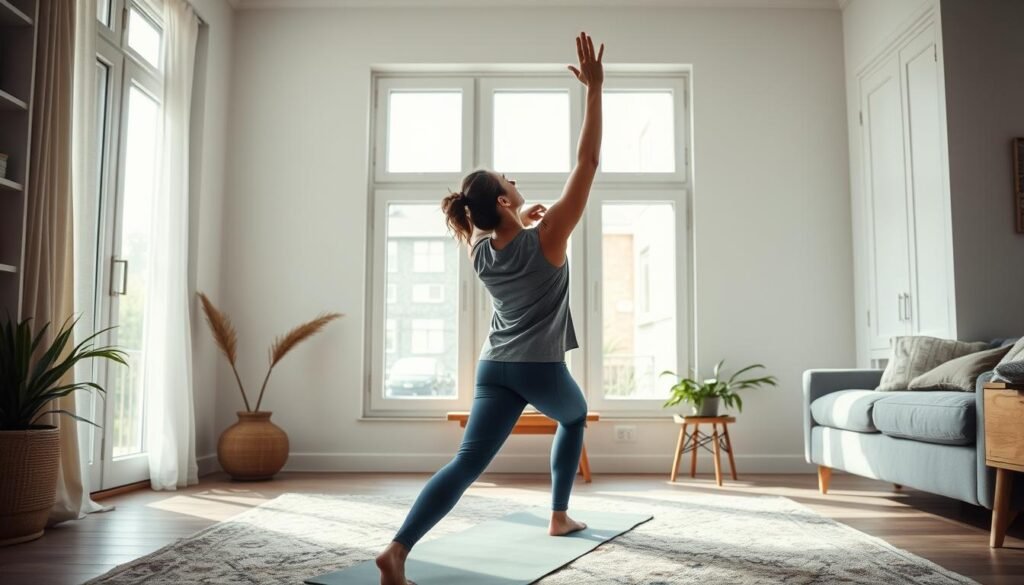
Overcome Gym Anxiety
Gyms can make you feel self-conscious, whether you’re just starting out or getting better at exercises. At home, you can wear what you like, practice form in front of a mirror, or take breaks without feeling judged. A study found that:
“75% of beginners avoid gyms due to fear of judgment.”
This freedom is why many people choose to work out at home. It takes away the pressure of being watched.
Focus on Personal Goals
At home, you can focus on your own goals without distractions. You can work on weak spots, repeat tough exercises, or try new things. There’s no rush to finish sets because of equipment. And you don’t have to compare yourself to others. It’s all about you and your goals.
Home workouts also let you track your progress privately. Whether it’s mastering a push-up or reaching a flexibility goal, you can celebrate your achievements on your own terms.
Family Engagement
At-home workouts are a great way to turn fitness into family bonding time. Your living room becomes a place where everyone can join in. Kids can try simple exercises, and grandparents can do chair yoga.
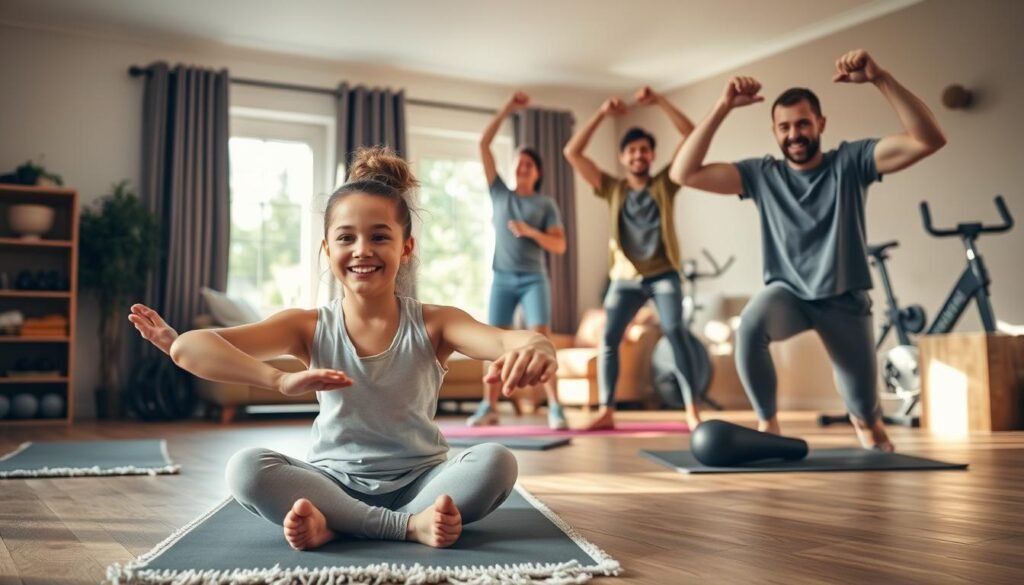
Multi-Generational Fitness Made Simple
Animal flows make exercise fun for kids and help adults build strength. Here are some fun activities:
- Bear crawls across the living room floor
- Family dance-offs to favorite playlists
- Yoga storytime with poses matching children’s books
“Children are 73% more likely to maintain active habits when parents participate.”
Collaborative Challenges That Build Team Spirit
Start weekly fitness quests that mix movement with household chores:
- Laundry basket relay races
- Staircase step challenges with progress charts
- Backyard obstacle courses using pool noodles
These activities offer health benefits of at-home exercise and cut down on screen time. They help kids improve coordination and adults manage stress. Plus, they create memories that last a lifetime.
Enhanced Time Management
At-home workouts make the most of your time. You can fit in high-impact exercise snacking even when you’re short on time. Just 10 minutes here and there can make a big difference.
Studies show that short bursts of activity are just as good as long gym sessions. Try squats while brushing your teeth or wall sits during phone calls.
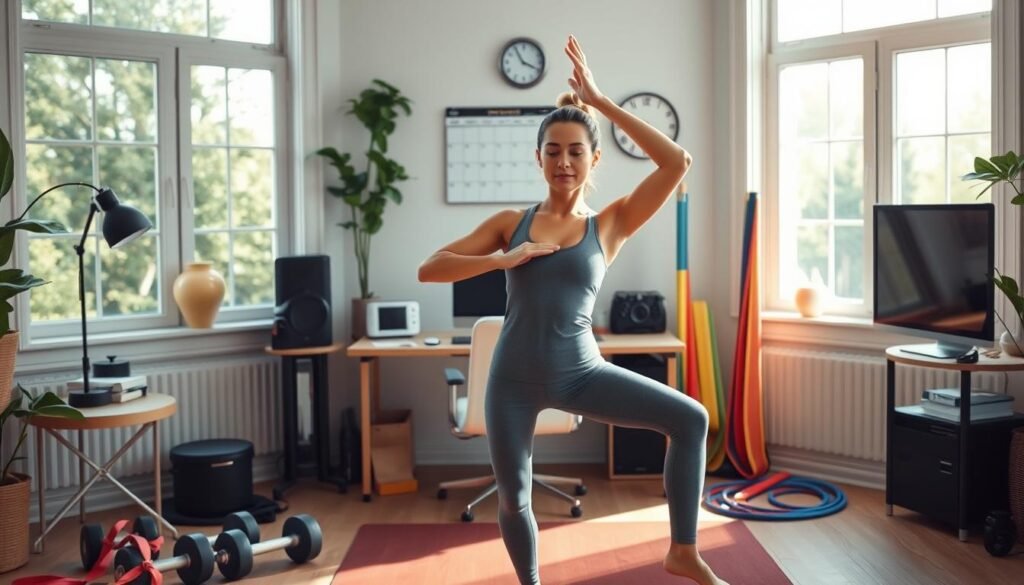
Maximize Your Workout in Minimal Time
Research shows that 20-minute routines can be more effective than an hour at the gym. Use time-under-tension techniques to build strength quickly. Focus on exercises that work many muscles at once.
- Push-ups with shoulder taps for core stability
- Lunges paired with bicep curls
- Plank rows using light dumbbells
Work out in 45-second bursts with 15-second rests. This keeps your workout under 30 minutes but keeps it intense.
Combine Workouts with Daily Activities
Make your daily tasks into workouts without changing your schedule:
- Do calf raises while waiting for coffee to brew
- Perform desk chair tricep dips during video calls
- Complete a 5-minute bodyweight circuit during TV commercials
These small workouts add up throughout the day. They can even be more effective than one gym session. Parents can even get their kids involved—try piggyback squats or stroller lunges.
Tracked Progress and Motivation
One of the biggest home workout advantages is seeing your progress right away. Unlike busy gyms, your own space makes tracking easier. You can see how you’re getting better, whether it’s with weights or yoga.
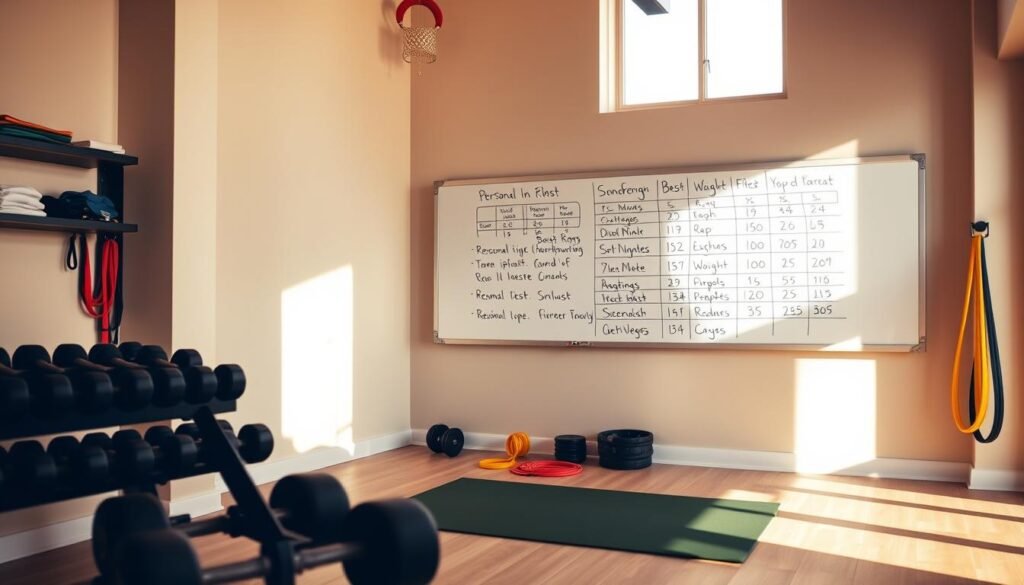
Keep a Workout Journal
Writing down your fitness journey helps you spot trends and celebrate small victories. Apps like Strong or MyFitnessPal make it easy to log your workouts and meals. Research shows tracking workouts can make you 30% more likely to keep going.
Here’s how to make the most of your journal:
- Write down how long and hard you worked out every day
- Use videos to check if you’re doing exercises right (as fitness pros suggest)
- Track how you feel to adjust your workouts
Monitor Your Achievements
Seeing real results boosts your motivation. Set goals like doing 50 push-ups or holding a plank for two minutes. Many apps turn your data into charts, making it easier to see your progress.
| Tracking Method | Benefits | Best For |
|---|---|---|
| Fitness Apps | Automated data analysis | Tech-savvy users |
| Written Journal | Personal reflection space | Goal-oriented planners |
| Video Recordings | Form correction | Technique-focused athletes |
Use these methods and check in with yourself weekly. Celebrate every success, big or small. Over time, these habits turn fitness into a rewarding journey.
Accessibility for All Fitness Levels
At-home workouts make you feel comfortable by letting you customize every movement to fit your level. They’re great for those recovering from injuries or starting out. Scalable routines mean you can always keep up, without feeling too much.
This flexibility is why 72% of beginners in Source 1’s study stayed with home workouts longer than gym ones.
Modifying Exercises for Beginners
Begin with easier versions to ease into it and build confidence. For instance:
- Try chair-assisted squats to get your form right
- Use wall or knee support for push-ups
- Resistance bands help build strength safely
Source 2 shows how changing exercises can be just as effective. For example, using step-ups instead of box jumps is easier on your joints but still keeps the workout intense. A physical therapist says:
“Modifications aren’t shortcuts – they’re smart strategies to build sustainable habits.”
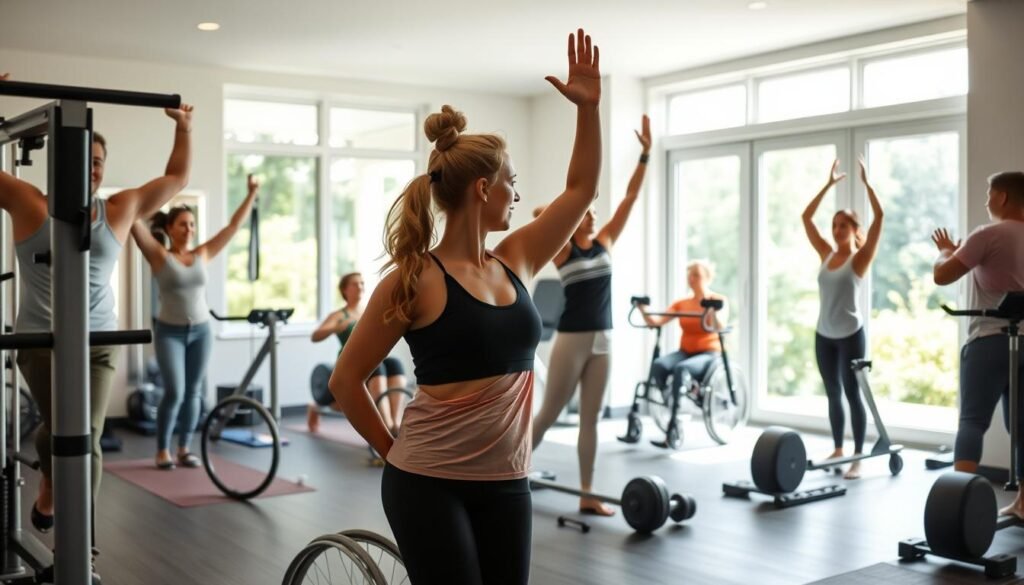
Progressing at Your Own Pace
When you feel ready, start making things a bit harder:
- Add pulses to lunges before jumping
- Try isometric holds in planks
- Change how fast you move (slower down, quicker up)
Source 1’s 12-week program shows that small, steady increases lead to 41% better results than trying too hard. Keep track of your progress in a journal to stay on track and avoid overdoing it.
Overcoming Common Barriers
Exercising at home has many benefits, but distractions and losing motivation can stop you. The good news is, you can overcome these challenges with simple strategies. Turn your home into a place of productivity.
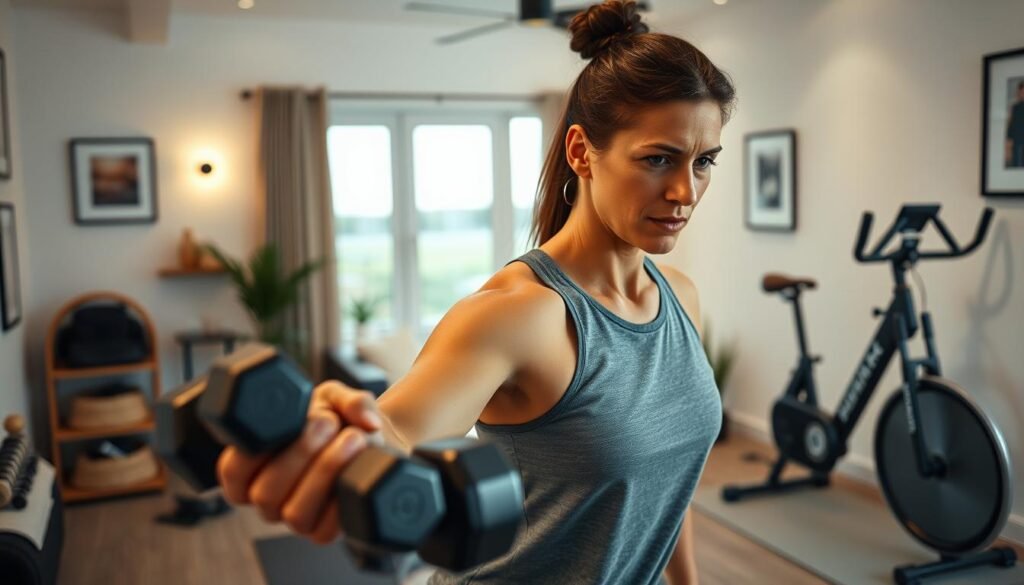
Combat Indoor Distractions
Household noise and clutter can distract you during workouts. Noise-canceling headphones help you focus. Decluttering your workout area also reduces mental clutter. Try these tips:
- Schedule workouts when it’s quieter
- Use apps like Focus@Will for music that helps you concentrate
- Display motivational quotes in your exercise area
For proper form without mirrors, check out NASM YouTube tutorials. Combine this with the American Heart Association’s tips on breaking down barriers to fitness for a full plan.
Staying Motivated Long-Term
Consistency is key for lasting results. Accountability partners help you stay on track—schedule virtual workouts or share progress photos. Here’s how to keep going:
- Set monthly challenges (e.g., “30-day core strength series”)
- Track your progress in a visible chart or app
- Reward yourself with non-food items like new workout gear
Virtual trainers through apps like Future or Apple Fitness+ offer personalized advice. Remember, small daily efforts lead to big changes.
Building Community Online
At-home workouts don’t mean you’re alone. Digital platforms connect you with others who share your fitness goals. These spaces turn solo routines into shared experiences, adding social support to the perks of flexibility and personalization.
Join Virtual Fitness Groups
Platforms like Strava and Fitbit Communities let you share progress and tips. You can celebrate milestones together. Live-streamed classes and forums offer support from certified trainers.
These groups add accountability without losing the convenience of home-based routines.
Participate in Challenges and Events
Virtual races and step-count competitions boost motivation. Apps like Nike Training Club host global events. You can track achievements with thousands of others.
Source 3’s research shows virtual challenge participants stick to routines 40% longer than solo trainers.
By mixing at-home workouts with online communities, you find lasting motivation. Follow certified trainers, join app-based challenges, and make your living room a place for growth and success.
FAQ
How do at-home workouts save money compared to a gym membership?
Gym memberships can cost over a month. But, you can get affordable home gear like resistance bands or yoga mats for less. Free apps like Nike Training Club or YouTube channels offer great workouts without spending a dime.
Can beginners modify bodyweight exercises for home workouts?
Yes! Start with easier versions like chair-assisted squats or knee pushups. As you get stronger, move on to harder moves like one-legged squats. This way, your workouts can grow with you.
How can I stay consistent with at-home fitness?
Use apps like Strong or MyFitnessPal to track your progress. Begin with short, efficient workouts to avoid burnout. Keeping a workout log helps you see how far you’ve come.
What if I have limited space for home workouts?
Even a small area can work. Clear a space, like a corner, and get creative with household items. Source 3 suggests using chairs for dips or walls for pushups, making the most of your space.
How do I avoid distractions while exercising at home?
Use noise-canceling headphones to block out distractions. Apps like Peloton or Apple Fitness+ offer immersive workouts. Source 2 recommends the NASM YouTube channel for tips on proper form.
Are there social benefits to at-home workouts?
Yes! Join online groups like Strava or Fitbit Communities for support. Source 2’s U.S. Registry of Exercise Professionals offers live sessions with certified trainers for a sense of community.
Can families participate in home workouts together?
Absolutely! Try fun activities like dance parties or animal flows. Source 3 suggests making exercise a family affair by doing fun, easy routines together.
How can I maximize short workout windows?
Use short bursts of exercise, like squats while brushing teeth or planks during TV ads. Source 1’s techniques, like slow squats, make the most of your time.
What if I’m self-conscious about my form or fitness level?
Home workouts are private, so you can focus on form without worry. Use mirrors to check your form and wear comfy clothes. Source 3 encourages you to work out at your own pace.
How do I stay motivated without in-person classes?
Set goals with apps like Fitbit or join online challenges. Source 2 suggests finding a workout buddy or tracking your progress to celebrate your achievements.

